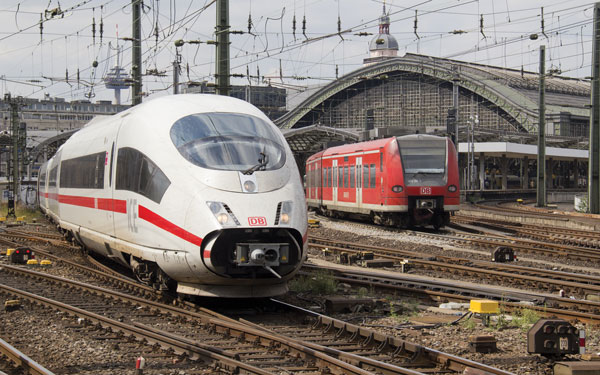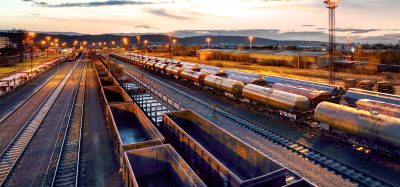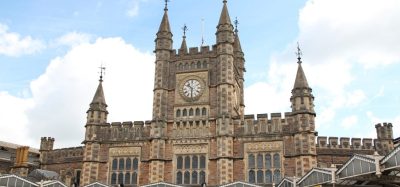New horizons for Germany’s railway industry
Posted: 23 March 2016 | | 1 comment
Sustainable mobility means quality of life: people want climate-friendly, affordable and convenient mobility, and Germany’s rail industry offers just that. For Global Railway Review, Ben Möbius – Managing Director of the German Railway Industry Association (VDB) – explains that continued future success for the German railway industry depends on delivering a ‘digital’ railway, strengthening industry cooperation, and building on growing a global presence…


Germany’s railway industry generates over half its revenues through export. More than 180 enterprises belong to the VDB, the industry umbrella organisation in Germany. Whether rail vehicles, infrastructure equipment, communications technology or services, technology made in Germany is the finest in the world and sets the standards for tomorrow’s mobility – a success story that we aim to continue, but achieving this depends on three prerequisites.
Firstly: promoting Rail 4.0
Germany’s railway industry is becoming increasingly digital, presenting enormous opportunities. Many travellers demand access to their digital worlds via Wi-Fi or on-board repeater technology when travelling by train. Offering the ‘anytime, anywhere’ platform enhances both the productivity and convenience of business and personal travel. But this isn’t the only ‘digital’ element of railways, for example:
- Modern, trans-national control and safety technology is finally replacing Europe’s patchwork and creating a unified European rail zone
- Electronic railway signalling installations act as efficient rail ‘nerve centres’
- Self-driving technology, which enables more frequent, customeroriented scheduling e.g. in urban metro networks
- Condition-dependent maintenance of rail vehicles and infrastructure to increase availability and safety
- Sensor technology that, for example, monitors the proper function of points
- Digital ticketing systems for more con – venient travel
- Intermodal data interchange, for example, between port terminals and the rail.
Rail 4.0 is all of this and more! And all these technologies in excellent quality serve but a single purpose: sustainable mobility.
Rail transport in Germany is already climate- and environmentally-friendly, accounting for just 6% of all carbon dioxide emitted in the transport sector; by contrast, trucks and passenger cars together account for over 85%. Shipping goods by rail instead of by road helps to protect the climate. For instance, a freight train pulled by a modern multi-system locomotive can transport as much freight as 28 trucks would on the Alpine transit route via the Brenner Pass – with two-thirds less CO2 emissions. Furthermore, in the rail sector, electromobility is a reality, and high-speed trains can replace air traffic on many intercity routes.
Modern logistics is based on the intelligent use of data. Condition-based maintenance, seamless interchange of information, for example, in combined-mode transport between ports and rail, intermodality, data analysis, data security – Rail Logistics 4.0 can result in the most efficient and climate-friendly possible transport of goods.
What can policymakers do? More than anything else, they can reinforce the innovative power, improve the regulatory framework and realise the uniform European market. Digitalised rail must be a European project. Europe has the best railway industry in the world. Politically, progress is being made – but is it fast enough? The unified European railway zone is one of the most important transportation, economic and climate objectives of the European Union – and rightly so. Yet it still does not exist. The key is to make trans-border travel more convenient for passengers and more efficient for freight. The European Rail Traffic Management System (ERTMS), the systematic improvement of infrastructure, the Trans-European Transport Networks (TEN-T), and more efficient certification processes could make this possible.
Secondly: strengthening cooperation to attain joint success
What is the German railway industry’s secret of success? Most importantly, in all likelihood, the close cooperation between the largest rolling stock manufacturers such as Alstom, Bombardier, Siemens and Stadler, as well as a globally unique diversity of highly specialised and predominantly small and medium-sized suppliers. Around 60% of the value creation of a rail vehicle today derives from the sourcing of components. Cooperation thus leads to success through innovation and quality. As a consequence, the industry is in a position to implement a turnkey conversion of the entire rail system. High-speed trains, locomotives, regional trains, carriages, metros, trams, track systems and electrification, digital control and safety technology, vehicle equipment, rail grinding systems, information and communication technology, extinguishing systems, telematics for intermodal networking, turnkey systems, low-noise braking and a wide range of components and subsystems – in all these areas, innovation promises the most resource-friendly, safest and most sustainable mobility possible. This promise is the product of cooperation. And the focus on innovation has a long tradition that goes back over 170 years. The German engineer and entrepreneur August Borsig built the first steam engine in Germany in Berlin in 1841. And Werner von Siemens invented the electric tram, which debuted in Berlin in 1881.
And particularly the broad diversity of small and medium-sized railway enterprises is unique in the world. Everything is available as leading-edge technology, from door and braking systems for high-speed trains to monitoring of component systems using ultramodern sensor technology. Innovation, greater productivity, lower costs – the SMEs played a key role in making Germany one of the world’s leading railway industry locations.
The German railway industry – from family-led ‘hidden champions’ to major train manufacturers – recognises its social responsibility: cooperation also provides orientation toward sustainability and ethical behaviour. The aim is to jointly realise solutions for efficient rail transport – and to act entrepreneurially in conformity with clear ethical principles; with transparency, without exception. To further this ambition, the German railway industry has committed itself to a Code of Conduct.
Cooperation also means working together with operators, academia, unions – and policymakers. We can succeed jointly – or not at all. Policymakers in Brussels and Berlin must urgently create the prerequisites for innovation wherever they can. This applies in particular to funding for research and development.
Thirdly: build on successes in the global market
The railway industry is a global player. The demand for German rail engineering is growing: over the last decade, the railway industry has expanded its business considerably, with revenues reaching a record €12.5 billion in 2014 – a gain of 25% over the previous year. This high-tech industry achieves over half its revenues through export business – no easy matter, as global competition is becoming much tougher. The railway industry is committed to open markets and fair competition world-wide, but the industry needs better political backing in Europe; particularly as Europe remains a key market – and still the largest in the world. The European Union could also help by pushing for a level playing field with transparent competition, fair rules and high standards.
Globally, the North American and Asia-Pacific regions are among the most important. In the latter, China is by far the leading rail nation. With a market volume of €18.7 billion and a growth rate of 4.2% annually, the Asia-Pacific region is incredibly dynamic. Many German railway companies were quick to grasp the enormous opportunities that collaboration with China opens up. With their own factories on site, they are the premier suppliers in China. Other enterprises have launched successful joint ventures with Chinese companies, and yet others are supplying China with sophisticated rail technology components from Germany.
The global growth in rail freight transport is the basis for progress. In China, for instance, rail freight is the backbone of the economy, accounting for close to 50% of freight transport. The share in the U.S. is over 40%. As rail freight transport is essential in Germany, for instance for connecting the largest port (Hamburg), and additionally runs through densely populated regions, the railway industry is focusing on solutions for low-noise freight transport. The line-up includes carriages and locomotives that fall significantly below the strict European noise limits. Noise from rail freight must be cut by half by 2020. Getting there will require conversion of carriages currently in service and investment in new, low-noise carriages and locomotives. Low-noise rail freight can improve the lives of neighbours worldwide.
The inhabitants of the world’s megacities want to be both mobile and smog-free. In view of chronic gridlocks and oppressive air pollution, more and more cities are urgently seeking environmentally-friendly alternatives – such as emission-free local and regional rail transport. This offers shorter commutes, greater comfort, and better air quality – in short, better day-to-day quality of life – for millions. This is reinforced by a further trend: many people prefer an urban, car-free lifestyle. This translates to greater demand for metro, tram and regional rail systems as well as the corresponding infrastructure – take North America as an example; numerous cities in the U.S. are experiencing a renaissance of local passenger rail as an answer to terminal gridlock. These growth markets will go to the suppliers who can provide the most intelligent solutions. One example is the self-driving metro, like in Nuremberg, which permits more flexible scheduling.
Although the German rail industry is acting globally, it has not lost sight of its home market. To achieve the best rail transport, Germany must remain a leading market. At the same time, leading suppliers need a leading home market. The dynamics of the home market is a key prerequisite for defending and expanding global technology leadership. Many projects serve as references: Germany is the ‘shop window of the railway industry’, and serves customers around the world. The most important product exhibition in the world also takes place in Germany: the InnoTrans event in Berlin. With visitor numbers growing year-after-year, this specialist trade show will again offer a highly differentiated spectrum of technical innovations, solutions and services for superior rail transport in 2016. Exhibitors from five continents testify that the railway industry has become a growing global business – and that the InnoTrans has become a unique performance showcase.
Rail transport can become the mode of the future: rail-based sustainability stands for social participation, prosperity, climate protection and quality of life – around the world. For the German railway industry, sustainable mobility goes hand-in-hand with excellent leading-edge technology. If the industry, government and operators jointly utilise the chances of digitalisation, to strengthening cooperation and to secure successes achieved on the global market, then tomorrow’s mobility will be made in Germany – and in Europe – making rail even more climate-friendly, economical and convenient for people.
Biography
Ben Möbius has been the Managing Director of the German Railway Industry Association (VDB) since May 2015. He studied political science and history in Hamburg, Bamberg and Cambridge. After having worked as a journalist for the Hamburger Abendblatt and F.A.Z., Ben started his career in the Federation of German Industries (BDI) in 2001as the Personal Assistant to, and Speechwriter for, the former BDI President, Dr. Michael Rogowski. Following this, Ben’s BDI positions included: Officer for European Affairs; Head of Office of the BDI President and the BDI Executive Board; Head of the Department for European Affairs; Head of the Department responsible for mobility, infrastructure, telecommunications and digital economy; Managing Director of the Traffic Committee of the BDI and the Committee for Digital Economy, Telecommunications and Media. Ben is a member of a number of advisory bodies and committees, including the Scientific Institute for Infrastructure and Communication Services, the trade fairs InnoTrans and Transport Logistics, plus on the Board of Editors for some industry technical magazines.









I like to know in more detail about Rail 4.0.